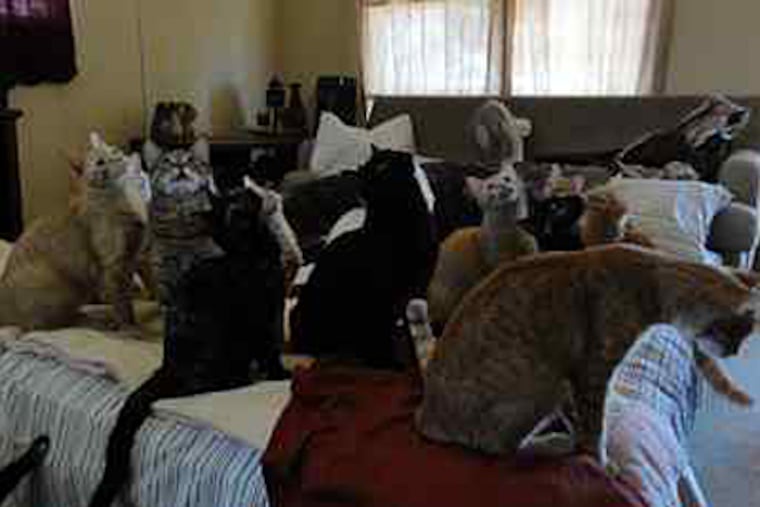Hoarding grows, and TV takes note
Barbara Paul already has set her TiVo to record the first episode of a new series on Animal Planet at 9 Wednesday night.

Barbara Paul already has set her TiVo to record the first episode of a new series on Animal Planet at 9 Wednesday night.
With good reason.
Paul is a Philadelphia assistant district attorney who prosecutes animal cruelty cases. The new program is Confessions: Animal Hoarders, a six-part look at people who keep more animals than they can handle.
The show is part of a wavelet of cable programs dealing with hoarders, whether of animals or objects. On Animal Planet's sister channel, TLC, viewers can find Hoarding: Buried Alive. A&E presents Hoarders.
All aim at understanding - and helping - people whose inability to part with possessions has brought them chaos and crisis.
Animal hoarding, though born of good intentions, can be devastating.
Last Tuesday, agents from the PSPCA raided an Olney home loaded with sick cats, dogs, pigeons, squirrels, chinchillas, beavers, and a fox.
The next day they had to don Tyvek protective suits and air-filter masks before entering a South Philadelphia rowhouse littered with 80 Chihuahuas.
Later that same day, they found 16 cats in a Mount Airy home.
Such cases are horrifying - but they are no longer rare.
"Situations like this go above and beyond a case of someone simply having more than the typical number of pets," says George Bengal of the PSPCA. "Animal hoarding is a problem that affects . . . every community in this country."
In Philadelphia, the number of large-scale animal hoarding cases went from one every six months in 2004 to one or two each month now. And the suburbs are not immune.
In 2009, police found 29 cats in a Harleysville home, in a locked bedroom that had no open windows and no ventilation. And that same year, PSPCA agents in Audubon, Montgomery County, found 115 sick and starving cats - Himalayans, Persians, Siamese, and Maine coons - in one squalid home.
"I honestly don't understand a lot about animal hoarding and I need to learn," said Paul.
"It does feel like an epidemic," she said, adding that the actual number of animal hoarders is probably much larger than the number of known cases.
"I believe there are many, many more cases in which people have not been caught," Paul said.
Concern about animal hoarding is so strong now that a Hoarding Task Force Symposium has been planned for July 28 at Bucks County Community College.Karen Cassiday, a Ph.D. clinical psychologist from Chicago who is treating animal hoarders featured on Confessions, says 40 percent of people who hoard objects also hoard animals.
Most start out trying to rescue animals. Despite their good intentions, they aren't able to care for the animals adequately and can't recognize when things have gotten out of hand. "They are unable to see that they're unable to care for the animals," she says.
Animal hoarders are often professional people, and there is some debate as to whether more women become animal hoarders. Like all hoarders, animal hoarders are in denial about their behavior.
Cindy Carroll, 54, an object hoarder from Westerville, Ohio, who appeared on the pilot of Hoarding: Buried Alive, said hoarders hide their condition. She said she hadn't invited anybody to her house over a five-year period.
Carroll had been hoarding paper, magazines, craft items, containers, and office supplies for 14 years. It got so bad that she eventually quit her job as a surgery scheduler.
She's not cured of her hoarding, Carroll says, "but I'm getting better," thanks to the organizer and psychologist that Buried Alive helped her find.
Hoarding activity seems to be set in motion by some trauma, Cassiday says, such as a death in the family or the onset of a medical problem. Carroll says that her object hoarding started when her son left home to live on his own and intensified whenever a similarly traumatic event occurred in her life.
Gary Patronek, a veterinarian who founded the Hoarding of Animals Research Consortium in Boston, also works with Confessions.
He points to a distinction between animal abusers and animal hoarders and says those two problems require different legal consequences.
"This is a very different type of animal cruelty happening," Patronek says. "In most animal cruelty cases, the perpetrator acts on purpose and takes pleasure in the animal's suffering."
"In animal hoarding, the perpetrator actually intends to help."
A more specifically targeted legal code, Patronek says, might allow intervention for animal hoarders at the point when neighbors first sense a problem, instead of waiting for it to turn into a disaster.
Patronek says he's seen hope in the last decade and thinks putting the problem on television can only help.
"Investigative agencies have gotten more sophisticated in how they handle animal hoarding situations. They have better strategies now. Instead of just taking the animals to shelters where they are euthanized, agencies set up M.A.S.H. units and arrange temporary shelters with foster networks."
As many as a quarter of a million animals - mostly cats and dogs - are victims of animal hoarding annually, Cassiday says. But by handling the cases differently, Patronek says, "the outcomes can actually be pretty good."
Animal hoarders "are very ambivalent about treatment," says Cassiday. "They never set out to be this way. They do love animals. They don't want to hurt them. [Treatment] is a sad, moving time for them."
But without psychological intervention, Patronek says, animal hoarders return to their old ways nearly 100 percent of the time.